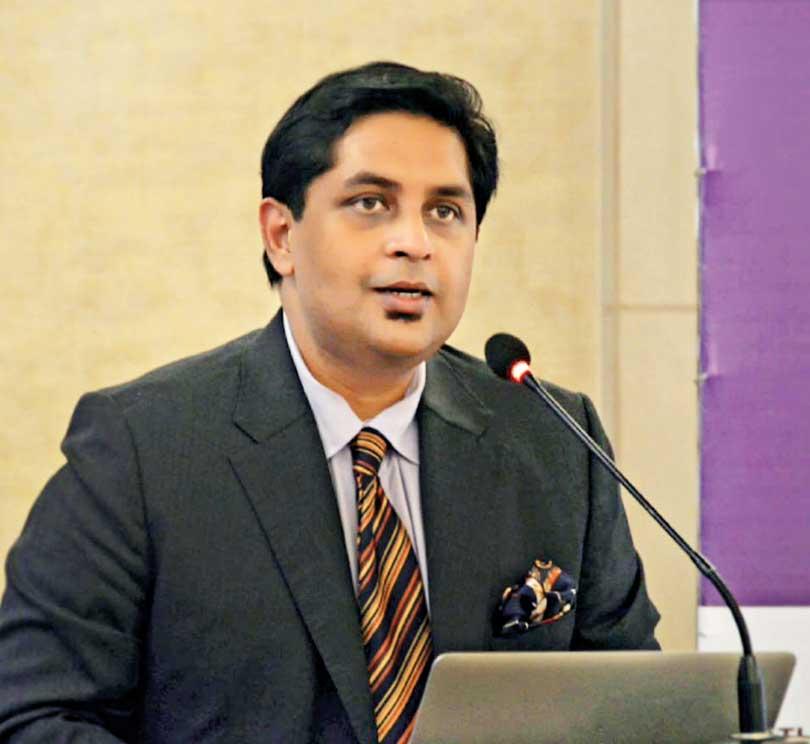Reply To:
Name - Reply Comment

 Prof. Shahab Enam Khan, a renowned academic of Bangladesh on security and political institutions, shares his thoughts on countering violent extremism and his country’s experience. He teaches international relations at Jahangirnagar University in Bangladesh.
Prof. Shahab Enam Khan, a renowned academic of Bangladesh on security and political institutions, shares his thoughts on countering violent extremism and his country’s experience. He teaches international relations at Jahangirnagar University in Bangladesh.
Q How do you describe Bangladeshi experience in countering violent extremism?
Well, Bangladesh suffered one major terrorist setback in 2016. It was a wake-up call for the country to deal with violent extremism and radicalisation. We have significantly been able to reduce and reverse the process of extremism in society. The government has undertaken comprehensive measures to tackle the menace of terrorism. All these efforts are proving right, however, like in any other country, there can be stand-alone experiences of terrorism.
Bangladesh has undertaken three significant milestones. One is that we have included the community. The law enforcement agencies are using approaches, that includes community resilience, working with the communities to serve their needs, preferences, customs and norms. We also have sufficient policy instruments in the legal framework including a well-designed anti-money laundering regime. That helps to deter and identify terror financing.
Thirdly, we are creating a community and social infrastructure against violent extremism. It means that the youths, the community leaders and the community actors are actively engaged in countering the extremism. Perhaps, the peaceful practice of Islam has always been in practice which works as deterrence against terrorism.
However, the stereotyping of any particular religion will always be counterproductive. The Bangladeshi society doesn’t allow stereotyping of any religion or ethnic identity which often contradicts the way global media projects Bangladesh. Stereotyping does not help, rather creates grievances and marginalisation. Bangladesh has done phenomenal progress in gender mainstreaming. We think women are the first victims of any kind of terrorism. Therefore, they would be the first one to respond. Hence, the role of women in countering violent extremism has extremely critical.
Q Actually, how effective is the role of women in this case?
This is where we are working and the work is in progress. First of all, educating women on religious verses and religious interpretations is gaining ground. It means we have to facilitate multiple interpretations of religious verses and practices, rather than monotonous interpretation, to enable people to choose their preferences. If you have a monotonous or one-sided interpretation of the religion, there is every chance that this can go wrong.
If you open up multiple channels of information, debates, or even interfaith dialogues, that will become social capital against extremism. Secondly, economic empowerment is there. This is where we have done a fantastic job. We have phenomenal NGOs- BRAC and Grameen Bank and alike. Their work actually works as deterrence too. Since women are the primary recipient of these institutions, women are becoming more capable to take decisions. That is certainly backed by strong political and social encouragements. Like Sri Lanka, we too have a kinship-based hierarchical society where women are a critical factor in educating and monitoring the activities and welfare of their children. As a result, the role of women, by their socio-economic contribution, should be firmer and the local authorities should provide them with all the supports – be it in schools or work or socio-political activities. Hence we advocate for more female leadership in society.
Q Bangladesh is predominantly Muslim society. What is the percentage of the radicalised segment?
Radicalisation is not a measurable phenomenon or process. At best we can identify some lucid indicators. Islam strictly prohibits violence and acts of killing in the name of religion. In fact, Islam endorses that there is no  compulsion in religion. The segment that may have become radicalised is so insignificant that it is always difficult to identify them.
compulsion in religion. The segment that may have become radicalised is so insignificant that it is always difficult to identify them.
The problem is that, then, because of this insignificant group – with their online and offline presence, the kinetic response is not preferable at all. As a result, the whole-of-government and society approach work better.
Radicalisation leading to violence has two dimensions. One is that you reduce vulnerability to radicalisation by empowering society. The other one is to counter it by ensuring effective law enforcement. Bangladesh has successfully reversed the process of the radicalisation in physical spaces but Internet remains as an Achilles Heel. As we grow more global, people are exposed to misinformation and fake news.
These exposures can always go wrong. Even in the case of mass shootings in the US or the recent Auckland shooting exposes the information and knowledge vulnerabilities. Then, we have the problem of rather misinterpreted or misrepresented Wahhabism. Wahhabist doctrines often contradict South Asian culture and values which Bangladeshis are used to. The religious pluralism often faces hitch due to non-compliance. Definitely, this is where we have to work on to preserve the tolerant versions of religion.
Q Bangladeshi people have traditionally been more conscious about their cultural and linguistic identity. But, they are now moving towards religious identity. How do you observe it?
This is a very complex phenomenon. Bangladeshi identity is composed of cultural and linguistic capitals. Bangladeshis strongly value their glorious political past based on pluralism and independent identity. However, religion plays a significant role in society. Hence, Bangladeshi society offers a balance of religion and liberal culture. That means religion doesn’t monotonously dominate the social fabric. Hinduism is well celebrated in the country, Christian culture and western culture exists peacefully and the nation celebrates all rituals and cultures.
Besides, the constitution guarantees equal rights for everyone. Hence there is no scope for segregation or class stratification. Of course, there is always a scope for improving the economic and political governance, but at the end of the state is the custodian of equality. However, like any other South Asian countries, we have to make sure collective growth and inclusive development.
However, the problem of the transnational organised crimes or extremist groups will continue to persist across the world. This is exactly where, like any other country including Sri Lanka, India, the U.S, we have to work on. That is to make sure that justice is properly delivered and inclusivity is ensured.
Q You face this problem as a Muslim country. In Sri Lanka, the Muslim population is nearly ten per cent. Still, we face this problem. How do you see it?
Sri Lankan Muslims are significantly different than Middle Eastern Muslims. In a sense, Sri Lankan Muslims historically co-existed with a majoritarian population. It is not the case in Bangladesh. It means they have adopted Sri Lankan cultural and social ecosystems to a great extent. Of course, every religion has its interfaces, hence like the Buddhist or Hindu population, rituals and social needs can be different for the Muslims or Christians too. Muslims have been part of Sri Lankan politics and an integral part of the phenomenal growth of the Sri Lankan economy. Majority of Sri Lankan Muslims are well-educated.
That makes them a unique population which is not to be compared with India, Bangladesh or the Middle-Eastern countries.
What we understand about the Sri Lankan case is that the recent events of terrorism are more linked with the transnational phenomenon rather than solely based on homegrown terrorism. It means there may be an extremely minuscule population that would endorse extremism in Sri Lanka. Majority of Muslim population cannot get radicalised due to social resilience and religious doctrines. More research is required. We certainly see that most Sri Lankan Muslims practices a tolerant version of Islam.
Q There are signs of Sri Lankan Muslims abandoning the local culture and adopting other cultural items such as wearing Hijab. How do you look at it?
There are always myths and misperceptions regarding Hijab or veil. We have to look at it closely. The population has increased so is the visibility of Hijab has increased. But that’s not the only point. Hijab does not necessarily always mean it is religious, women have various reasons to wear Hijab/veil including public safety, physical or social abuse (Depending on their location), or often by choice and family traditions. Moreover, Hijab/veil has multiple meanings in the Abrahamic religions. Hence, hijab can be both religious and/or social. A deeper understanding and research should be done.
Q How can Bangladesh support Sri Lanka in countering violent extremism?
We have developed reasonably effective technical and institutional capacities to detect, deter, and deny extremism. We have done considerable research to understand this phenomenon. Whenever we approach these problems, we go through a comprehensive mechanism. This is something Sri Lankans can largely benefit from. Bangladesh’s experience can serve as a good lesson for the Sri Lankan society.
Q What about the regulation of Madrasahs?
Madrasah governance is another milestone where Bangladesh has achieved positive results fast. Madrasahs – be it formal or informal- are now under the radar of the government. We cannot change everything overnight but the process has kicked off well. There are two kinds of Madrasahs- Alia Madrasah and Qwami Madrasah. Alia Madrasah is the one under the government like any other educational institutions. The Qwami Madrasahs are now under regulations. It will take time to modernise the Qwami madrasahs.
Q What about teachers?
We certainly recognise that the quality of teachers teaching in the Madrasahs need to be improved. The problem is that we earlier had unregulated growth of religious centres- mosques and other religious institutions. Now the government is increasingly being introduced through policies and regulations where needed. The government, along with remarkable supports of the NGOs and the international community, is focusing on skills and capacity buildings of the teachers and religious clerics. Late but surely we have started which is being supported by the society as a whole.
Another important aspect is the newer but parochial version of Islam is often being publicised. For example, Wahhabism. Wahhabism is not a South Asian phenomenon for sure. It originates from Saudi Arabia with multiple interpretations. South Asia always practised a tolerant version of Islam which is a mix of different culture and in line with the local culture. Hence, people often get confused in determining the right and the less right versions of religion.
Another important aspect of radicalisation is prison radicalisation. A prison is a place where people get much more amalgamated- the same type of people with cognitive and social vulnerabilities. Prison de-radicalisation is a challenge. This is something Sri Lanka might have to look into at one point. We are now focusing on cognitive engineering or social psychology has become another dimension for any society to deal with. We have to focus on psychological welfare and sound growth of the younger generous. We have to equip them with tolerance and pluralism, and that should start with the parents and adolescents. Reaching out to the youth to build their own resilience will be more productive than only reaching out to the older generations and age-old governance institutions. hence, social development and progress are the keys.
Q You mentioned economic empowerment as a means of weaning people away from radicalisation. Yet, radicalised members are sometimes from well-to-do families. They are also educated. How do you comment?
The Holey Artisan attack (The 2016 attack on Dhaka cafe that left 22 dead) demystified that only the poor are vulnerable to extremism. Extremists can come from any segment of society. Some of them were well educated and from rich families. This is no longer a hypothesis that only the vulnerable and the poor are into radicalisation and extremism. In many cases, the masterminds of extremism were found to be well educated, look at the founders of IS or AQIS or even the ones belonging to white supremacism. The foot soldiers are generally from multiple backgrounds though predominantly from the lower-income group. The lone wolves are coming from both rich and poor segments. That means it is difficult to generalise the backgrounds and indicators as yet.
Q How important is community participation in identifying radical elements?
That is extremely important. The voices of the marginalised, alienated, and deprived population must be heard. This is both social and political responsibility. If you look at what happened in Auckland last year, the New Zealand government reached out to the Muslim community to create a buffer against terrorism. They have reached out to the overall society for solutions and resilience. That’s a solid practice that should be followed. Bangladesh follows non-Muslim participation in its decision-making processes too. Extremist trends show that they no longer focus on one specific community or identity, even the Muslims are victim of so-called Islamist militant groups. By empowering the Muslims against extremism in Sri Lanka, better results will be found. Hence, you cannot resolve the religious crisis or the potential for social polarisation only through military or law enforcement principles. This is unanimously agreed across the world. Social tolerance, cultural resilience, cultural norms have to be taken into consideration. Sri Lanka is emerging as a critically important country in the global geopolitical and geostrategic power equations, hence Sri Lanka’s fabulous cultural integrity and stability should collectively preserve.